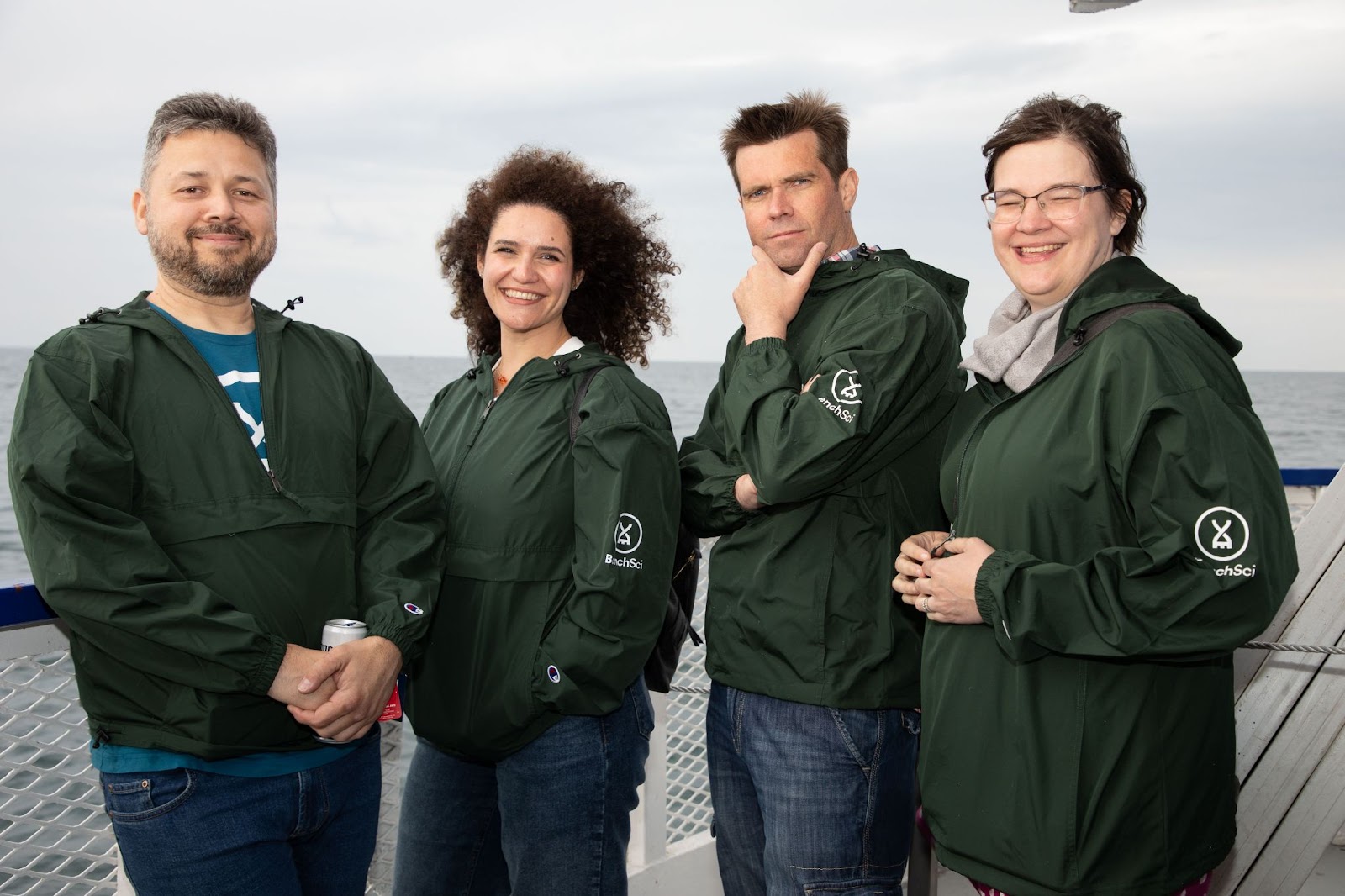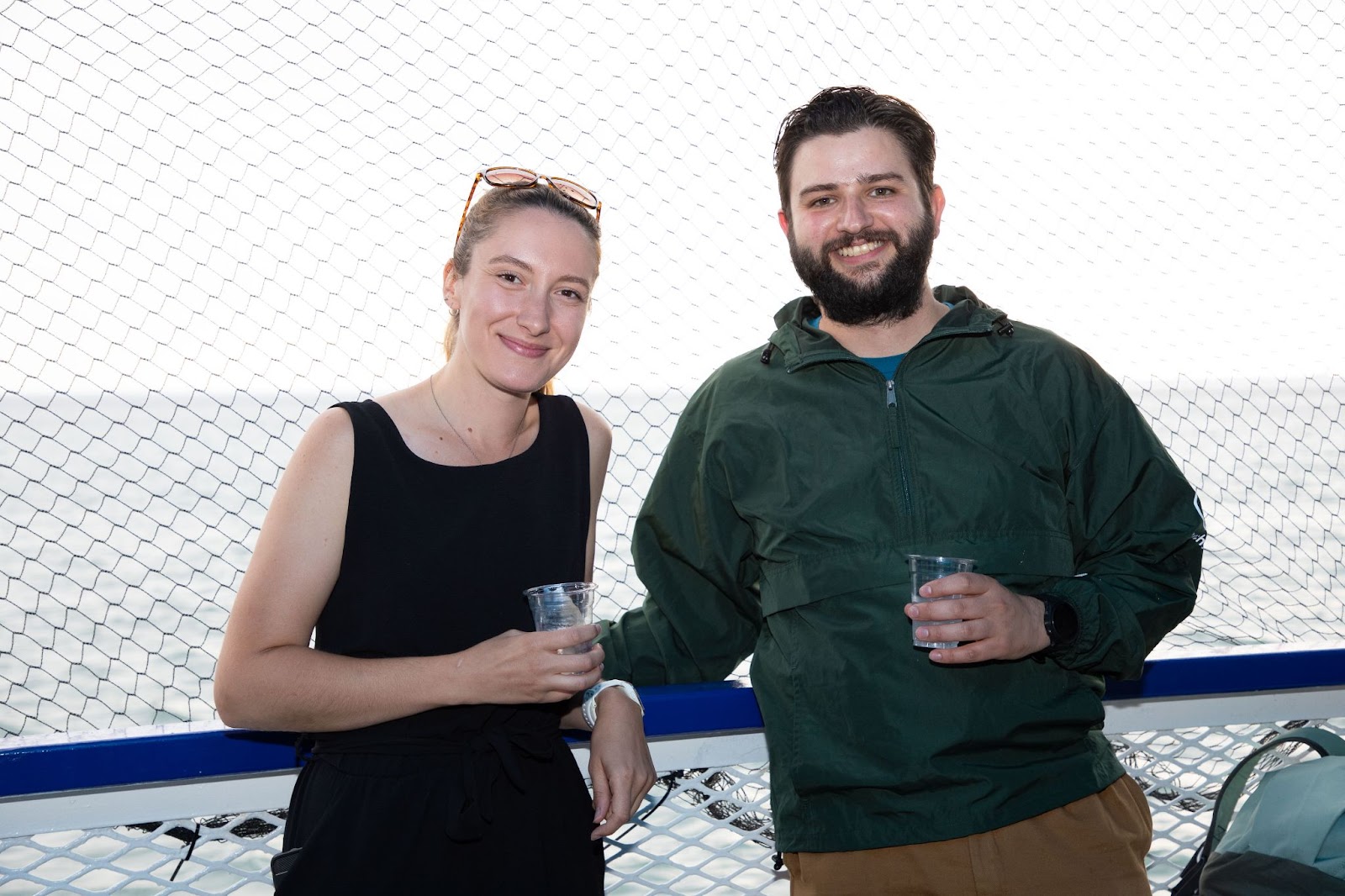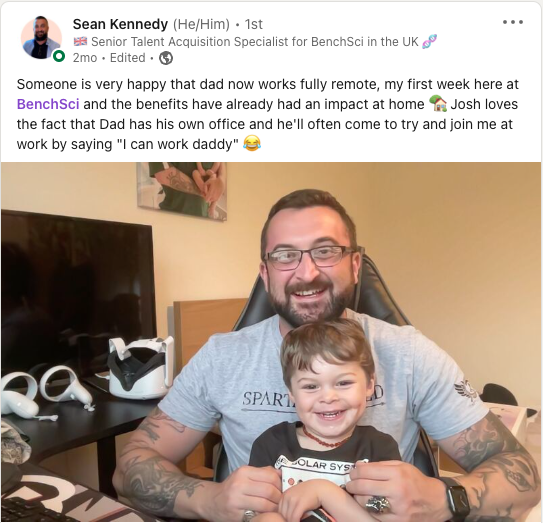While we started out in Canada, today BenchSci is a remote-first company with over 300 employees across the world. We’ve been steadily growing in several countries and the United Kingdom is no exception! This week we are spotlighting three of our UK-based team members: Fred Phillips (Engineering Manager – Data), Laura Clarke (Senior Project Manager), and Sean Kennedy (Senior Talent Acquisition Specialist).
While they work in different areas of the company, they each opened up about what it is like to work remotely for BenchSci while collaborating with team members in multiple time zones. Watch the video below to hear their thoughts on life at BenchSci and read on to learn more about each of them.
Why did you choose BenchSci?
Fred: I chose BenchSci because I was looking for a company that aims to have a positive social impact and is actually delivering on it. It’s also science related and I come from a bit of a science background. But in the end, what convinced me was all of the people I spoke to during the interview process who seemed to genuinely like working here and were really bought into its mission.
Laura: I chose BenchSci partially because I knew James Malone, so I knew that BenchSci was a lovely place to work, but also I was looking for opportunities to continue help build services that help scientists have the right data to conduct the right experiments as that was the background that I came from. BenchSci’s mission as a whole felt like a very good fit in that respect.
Sean: For me, the mission really pulled on the heartstrings when I was doing my research. What BenchSci’s Big Hairy Audacious Goal is to get medicine to patients 50% quicker in time. That would’ve been fantastic for 14-year-old me with my granddad who was really sick, dying of cancer, and didn’t have the right medicine to kind of ease his life. He was going to die. We knew that, but his standard of living got really bad towards the end. I think there are certain medicines now that are available, that weren’t available then. And if there was potentially something like BenchSci that was helping speed that process up, he could have had his final months could have been a lot more peaceful.


Members of our UK, US, and Canada teams together for BenchBreak 2022
What does a typical day at work look like for you? What time do you start?
Fred: I start work at 10:30 AM UK time. I have my hours slightly shifted later to overlap with Canada more. A typical day usually starts with me trying to do my deep work or doing items from my to-do list without any distractions. Around lunchtime, I’ll have lunch and also try and catch up on what happened the day before after I logged off but before Canada did. I try and get all this stuff done before my colleagues come online. And then the rest of my day is usually synchronous meetings with the team. I have a daily standup with my team and then I also catch up one on one with all my direct reports once a week, and talk to other people we are working with across the company.
Laura: UK hours are 10:30 AM to 6:30 PM, which is quite actually nice. It means you get a leisurely morning start, but you’re not working until too late in the evening. I think BenchSci gets work-life balance and makes sure that, almost without exception, we’re not expected to work after 6:30 PM. There are occasional meetings that run until 7 PM and even more occasional ad hoc things that have to happen later because we have people all the way from the west coast through to the UK. Most of the time, everything that I need to do can be fit in that 10:30 AM to 6:30 PM timeframe.
Sean: I work from 10:00 AM to 6:00 PM. A lot of my day is spent interviewing. Prior to the interviews though, there’ll be a lot of kind of research into the roles we’re hiring for and speaking with hiring managers to assess what roles they need. I’ll also be going through our searches, headhunting, putting out adverts, responding to adverts and people that are applying, and working with prospective candidates.
How do you stay connected to your team members in a remote-first organization?
Fred: My team is split between Canada and the UK so it can be a challenge, especially with time zones. We do a couple of things to deal with that. For starters, we’re always in constant contact on Slack during the working day. And then we try and work asynchronously on tasks that can be done that way. That gives us more time when we’re actually overlapping in our hours to focus on what needs to happen synchronously. We also make sure we leave time to talk about non-work things as well. Working in an office gives you a really natural way of having non-work-related conversations, but remotely, you also need to carve out the time specifically to do this. You don’t have that time between the meetings because you just hang up your call and then you don’t see them anymore. We also meet up in person every quarter to make sure we do a mixture of work and non-work-related things.
Laura: A significant amount of communication is done via Slack. Instant messaging has some upsides in the terms of its very real-time and you can have rapid back-and-forth communication with people. Although it does have its downsides because of course, text communication is just slightly lower bandwidth than verbal communication so it can take longer to get to a shared understanding. Also because I work mostly in UK hours, there are occasions when most of the people aren’t online. I have to sometimes hold a question until other people appear online or throw it out into the ether and wait for someone to respond when they start work (which they mostly do).
Sean: There are loads of different ways. You can jump on calls and use Slack. We use all kinds of different methods just to stay connected and stay communicating with one another which is really good because obviously, you’re working from home. You are kind of by yourself, but you don’t ever have that feeling that you are by yourself. You always know there’s a safety net. You always know there’s someone there that you can speak to.
What is the biggest misconception people have about your remote job?
Fred: I think the biggest misconception I hear from people is that it’s boring or lonely being at home by yourself. Obviously, everyone is different, but I still spend a lot of my day talking to people. I think even though it is important to talk to and meet with people in person, I don’t think it has to be every day of the week. I think that’s something that you realize when you start working remotely. You can still have these connections, even if you only physically meet up less frequently.
Laura: I think maybe there’s some skepticism as to how effective remote working can be. This is where the amount of effort that the company as a whole is putting in to make sure that remote working is functioning properly matters. At BenchSci, we have this program called Donuts where you get virtually introduced to other members of the company who you may have bumped into while buying a coffee if you were all physically in the same location. That of course doesn’t happen because we are remote, so it’s a nice way to meet other people across the organization that you wouldn’t meet naturally but it doesn’t feel false. It’s been really nice how open the majority of people are to have those random 15 or 30-minute chats.
Sean: Very few of my friends work remotely, so all they think is that you just roll out of bed whenever you want and jump onto your laptop and go from there. But remote working is there to give you a better standard of living. My hours are 10:00 AM to 6:00 PM. I’ve got a three-year-old and there’s no chance that I’m staying in bed till 10 o’clock every morning. I get up in the morning. I go for a walk or I go to the gym. I prepare myself. I actually get a chance to have breakfast, which was never a thing for me before. You know, there are little things that help set up your day with remote working and give you that better standard of life.
What’s the most interesting project you’ve worked on at BenchSci so far?
Fred: Part of my team’s remit is to get make sure we’re getting the data to our clients in the shortest time that we can. This involves a lot of working on technical optimizations of things, making sure our queries are as efficient as they can be, making sure our databases are configured the most efficient way, and also working with other data teams, the company as well, to make sure that they are fitting in with our whole data pipeline.
Laura: I’m doing project management for the Bioinformatics and Machine Learning teams. One initiative that’s happening within Machine Learning is trying to use new techniques to be more accurate about how we tag meaningful words and how we identify those words as being different concepts such as a gene or a disease.
Sean: Our UK expansion project at the moment has got to be the number one for me. I thought when I came on board, you know, I’d have a say here or there, but the team has really responded well to any suggestions I’ve had or any input I’d be able to give. It was quite a nice shock.
What are three words you would use to describe our culture?
Fred: Three words I used to describe the culture are “working well together.” What’s really struck me about coming to work at BenchSci is how it feels like we’re all part of the same team. I spend a load of my time talking to different people all around the company which is really great. It feels like we’re all coming together to work toward our goal.
Laura: Having been here for maybe four months. I’d go with: open, friendly, and determined. Everybody’s committed to achieving BenchSci’s goals.
Sean: Three words: “educational”. You’re constantly growing on yourself and educating yourself. “Respectful” we have a deeply respectful culture here of anyone and all communities. And “caring”! There is a really caring culture here and I’ve enjoyed going to work every day.
What’s your favorite snack?
Fred: My favorite British snack is probably Mini Cheddars! Mini Cheddars are little crackers, which you get in a packet and they’re cheese flavored and they’re circular. They also have a flavor that has Branston pickle in it as well, which is pretty great.
Laura: I’m a big fan of crisps and there’s a style of crisp called Nik Naks which is a crazy name. They’re sort of like a corn-based crisp. There is also a flavor called Nice ‘n’ Spicy Nik Naks which is very tasty.
Sean: It’s not British, but it’s a part of a British diet: a Doner kebab. I’ll be honest. You’re more than likely to get a Doner kebab at two o’clock in the morning. It’s that kind of food you get at that time, but I’m an oddball and I would I’ll eat one at midday.
–
Come join our team! Visit our Careers site for available roles and subscribe to our blog to stay up to date with all things BenchSci.
